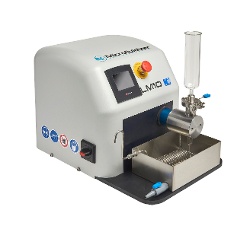In this blog, we cover some of the basics relating to Cell Disruption and the Cell Disruption Process, a key application for our Microfluidizer® Technology. Before we cover some of the options and equipment, we need to answer the question.
What is Cell Disruption?
Cell disruption is the process of breaking open (otherwise known as lysing) cells in order to obtain the intracellular fluid (commonly referred to as lysate). There are a variety of intracellular components that may be desired to obtain via cell disruption, including proteins and viral vectors that are not expressed extracellularly.
Cell disruption is an essential step during the manufacturing of many biological products such as enzymes, nucleic acids, antigens for vaccines, and viral vectors that deliver genes for next-generation vaccines or gene therapy. Cell membrane disruption specifically refers to the disruption, or lysis, of the cell membrane.
What does it mean when a cell lyses?
Cell lysis is the breakdown of a cell in order to access the intracellular fluid or lysate. Typically, when a cell is lysed, the cell membrane wall is broken. This allows the person who ruptured the cell to access the lysate.
What are the methods for mechanical cell disruption?
Common methods used for mechanical cell disruption include the utilization of a Microfluidizer® processor, bead milling, sonication, high-pressure homogenization, and French press.
How can High Shear Homogenizers be used for cell disruption?
Microfluidizer® processors utilize a fixed geometry Interaction Chamber™, which contains a micro-channel, in combination with high pressure (up to 30,000 psi) in order to create the appropriate shear rate in order to lyse cells. Microfluidizer® processors focus on constant pressure processing, which ensures uniform and repeatable results.
Additionally, while this high-energy method can result in a temperature rise, which can be damaging to certain intracellular components, temperature control options are available to immediately cool the sample down. A multitude of companies utilize Microfluidizer® processors for cell disruption and don’t see temperature-related issues including denaturation of proteins.
Bead Milling
Bead milling is the process of passing particles through a chamber containing small beads, typically made out of either ceramic or metal, which work to grind the particles.
When processing cells, this grinding mechanism can be used to lyse them. However, this method experiences issues surrounding temperature control and contamination from the beads themselves.
Sonication for cell rupture
Sonication uses the forces of ultrasonic waves in order to rupture cells. While this can be an efficient method to rupture cells, issues arise around temperature control and scalability.
High-pressure homogenizers for cell disruption
High-pressure homogenizers are typically valve-based systems that utilize the high shear forces that result from forcing material through a small orifice at high pressures to disrupt cells.
Temperature control in these systems can be difficult, and the valve-based nature, which prioritizes constant volumetric flow rate vs. constant pressure, can lead to inconsistent processing results. 
A French press is similar to high-pressure homogenizers in that it combines high pressure with a small orifice to disrupt cells.
However, the use of a French press is a very manual process, which is not scalable and does not have good temperature control.
Cell disruption resources and further reading
We have a range of resources available that focus on Cell Disruptors, Cell Lysis, and Homogenization, as well as application notes. Learn more about the advantages of using Microfluidizer® Processors for Cell Disruption
You can download the app notes from the button below - Cell Lysing for Gene Therapy.
Posted by
Matt BaumberTopics:
Cell Disruption
